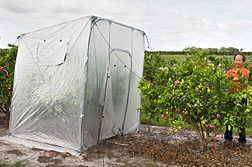This page has been archived and is being provided for reference purposes only. The page is no longer being updated, and therefore, links on the page may be invalid.
| Read the magazine story to find out more. |
|
|
Recipe for HLB-affected Citrus: Apply Heat—Lots of It
By Dennis O'BrienAugust 5, 2013
U.S. Department of Agriculture (USDA) scientists are literally turning up the heat on citrus greening as part of new technology they've developed to control this devastating disease that threatens the Florida citrus industry.
Citrus greening disease, also known as Huanglongbing (HLB), is the most serious threat to the Florida citrus industry in its history. It's costing the industry millions in losses each year, and there is no known cure for HLB and no commercially viable, effective treatments.
But USDA Agricultural Research Service (ARS) scientists in Fort Pierce, Fla., have found that heating potted citrus seedlings in growth chambers can rid seedlings of HLB symptoms. What's more, encasing infected trees in plastic tents to heat them in the sun also can prolong their productivity, according to Yongping Duan, an ARS plant pathologist at Fort Pierce.
ARS is USDA's principal intramural scientific research agency, and this work supports the USDA goal of promoting international food security.
Duan and his colleagues at the ARS U.S. Horticultural Research Laboratory exposed HLB-infected citrus seedlings to different levels of heat in growth chambers for periods ranging from two to 10 days to evaluate its effects. The seedlings were about 2.5 years old, about two feet tall, and were grown in one-gallon containers. They were heated to constant temperatures of 104 degrees, 107 degrees, or 113 degrees Fahrenheit. Fluorescent lamps provided light for 12-hour "day-time" cycles, and were turned off for the same lengths each "night." Infection levels were measured a week before heat treatments began, and again 30 days, 60 days, and 270 days after the treatments ended.
The results, published in the journal Phytopathology, showed that exposing citrus seedlings to a minimum of 48 hours of temperatures of 104 to 107 degrees Fahrenheit significantly reduced and often eliminated HLB infection. Monitoring showed the effects can last for at least two years.
In a separate field study, the researchers encased infected trees in opaque, plastic PVC "tents" to heat them up for about a week, then removed the tents and trimmed the top 10 or 12 inches of the trees that were "browned up" by the solar heat. Preliminary results show that the solar heat triggered disease remission and prolonged the trees' productivity.
Applying heat by increasing the ambient temperature seems to work best in nurseries and greenhouses with constant temperature if the infection is in its early stages and hasn't yet reached the plant roots, according to Duan. Additionally, heating trees in solar tents may offer relief to some growers whose citrus groves are being devastated.
Read more about this research in the August 2013 issue of Agricultural Research magazine.

